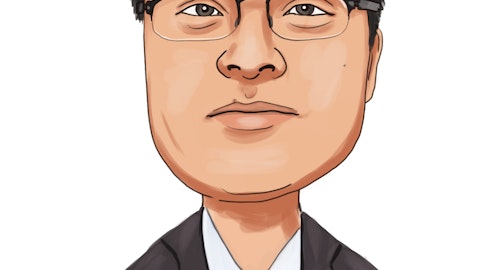Hanmi Financial Corporation (NASDAQ:HAFC) Q4 2023 Earnings Call Transcript January 23, 2024
Hanmi Financial Corporation beats earnings expectations. Reported EPS is $0.61, expectations were $0.6. Hanmi Financial Corporation isn’t one of the 30 most popular stocks among hedge funds at the end of the third quarter (see the details here).
Operator: Ladies and gentlemen, welcome to Hanmi’s Financial Corporation’s Fourth Quarter and Year-End 2023 Conference Call. As a reminder, today’s call is being recorded for replay purposes. [Operator Instructions] I would now like to turn the call over to Larry Clark, Investor Relations for the Company. Please go ahead.
Larry Clark: Thank you, Alisha, and thank you all for joining us today to discuss Hanmi’s fourth quarter and full year 2023 results. This afternoon, Hanmi issued its earnings release and quarterly supplemental slide presentation to accompany today’s call. Both documents are available in the IR section of the Company’s website. I’m here today with Bonnie Lee, President and Chief Executive Officer of Hami Financial Corporation; Anthony Kim, Chief Banking Officer; and Ron Santarosa, Chief Financial Officer. Bonnie will begin today’s call with an overview, Anthony will then discuss loan and deposit activities, and Ron will provide details on our financial performance, and then Bonnie will provide closing comments before we open the call up to your questions.
Before we begin, I’d like to remind you that today’s comments may include forward-looking statements under the Federal Securities Laws. Forward-looking statements are based on current plans, expectations, events and financial industry trends that may affect the Company’s future operating results and financial position. Our actual results may differ materially from those contemplated by our forward-looking statements, which involve risks and uncertainties. Discussion of the factors that could cause our actual results to differ materially from those forward-looking statements can be found in our SEC filings, including our reports on Forms 10-K and 10-Q. In particular, we direct you to the discussion of certain risk factors affecting our business contained in our earnings release, our investor presentation and in our Form 10-K.
With that, I would now like to turn the call over to Bonnie Lee. Bonnie, please go ahead.
Bonita Lee: Thank you, Larry, and good afternoon, everyone. Thank you for joining us today to discuss our fourth quarter and full year 2023 results. I am proud of our team’s performance as we finished 2023 with a positive momentum delivering solid fourth quarter result and building a good foundation for 2024. As all of you are aware, the industry faced notable challenges during the past year. I believe our team successfully navigated these challenges as we have done so in the past by focusing on the execution of our long-term growth initiatives and proven diversification strategy. We continue to do what we do best; build and expand our customer relationships by providing the products and services our customers need in this ever-changing world.
During the past year, we further strengthened and expanded our business executing on our relationship-driven banking strategy. We also focused on strong credit administration, which was essential given the uncertain and dynamic macro environment. In addition, while we could not avoid inflationary pressures, we did exercise disciplined expense management while continuing important investments in personnel and technology. Our diversified lending capabilities allowed us to grow our residential mortgage portfolio by 31% for the year despite the challenging interest rate environment. Our asset quality remained excellent during the year with very low delinquencies, nonperforming assets and net charge-offs. We also pursued optimizing our branch network with opening of two new branch locations in markets with a great growth potential.
These are just a few examples that give me confidence that we have the right strategy and the right culture to address the challenges of 2024. Now, let me review some highlights for the past year. Net income for 2023 was $80 million, or $2.62 per diluted share. Our return on average assets was 1.08% and our return on average equity was 10.70%. As expected, given the higher interest rate environment and economic uncertainty, overall our loan growth was constrained to 3.6% for 2023. Our deposits grew by 1.8% for 2023 and we ended the year with a healthy mix of noninterest bearing deposits at 32% of the total deposits. This is especially encouraging given the competitive nature in our markets in this particular environment. We managed our noninterest expenses diligently.
Expenses increased by less than 5% for the year as we were able to offset the inflationary pressure on salaries and employee benefits with the cost savings and other expense categories. Importantly, asset quality remains strong as we continue our focus on high-quality loans, disciplined underwriting and vigilant credit administration practices. As a result, criticized loans were down 23% year-over-year. Net charge-offs for the full year of 2023 were a low 0.12% of average loans and nonperforming assets ended the year at 0.21% of the total assets. Last, we finished the year with a solid financial position and very strong capital ratios. This positions us well for continued growth in 2024 and beyond in a safe and sound manner. Looking ahead to 2024, we see continued uncertainty about the economy and interest rates.
As a result, we will remain vigilant in our credit practices, prudent in our growth objectives and disciplined with our operating expenses. As I have mentioned, I am very pleased with our diversified lending capabilities. For 2024, we will explore the use of our production capabilities in residential mortgages and equipment finance agreements towards the secondary market activities to generate another source of noninterest income and assist in balance sheet management. Our Corporate Korea initiative continues to deliver strong results, with the deposits from these customers increasing 42% for the year. During the later part of 2023, we made a good progress in our efforts to increase awareness of this strategic growth initiative and this month, we entered into a memorandum of understanding with the Korea Creative Content Agency under which we will jointly work in helping Korean content companies expand into U.S. market.
We believe this will further propel our USKC initiative. As I noted earlier, we opened new offices in two markets and we believe have a great growth potential. For 2024, we will continue to analyze our banking network for consolidation, relocation and growth opportunities. Finally, we’ll continue to make strategic investments in our people, technology and infrastructure. We want to ensure that our team is empowered to bring the innovative thinking, adaptability, and collaborative spirit needed to drive sustained growth. We believe our technology and infrastructure improvements will help drive operational efficiencies and deliver improved profitability, ultimately creating more value for our shareholders. So for 2024, we remain committed to executing our strategy.
Our consistent performance and growing reputation as a preferred relationship-based banker is enabling us to increase the number of communities we serve. I’ll now turn the call over to Anthony Tim, our Chief Banking Officer, to discuss fourth quarter loan production and deposit gathering in more detail.

Anthony Kim: Thank you, Bonnie, and thank you for joining us today. I’ll begin by providing additional details on our loan production. Fourth quarter loan production was $390 million, up $53 million or 16% from the third quarter, with a weighted average interest rate of 8.1%, up from 7.8% last quarter. The improvement in loan production was due primarily to growth in commercial real estate and SBA lending, while C&I and equipment finance production moderated from their strong third quarter levels. We remain committed to pursuing high-quality loans that meet our underwriting standards and provide attractive yields in the current rate environment. CRE production was $178 million, up $72 million from the third quarter. $44 million of the increase came from the Corporate Korea loans as our efforts to grow those relationships continues to bear fruit.
We continue to be pleased with the quality of our CRE portfolio. It has a weighted average loan to value ratio of approximately 49% and a weighted average debt service coverage ratio of 2.2 times. SBA loan production improved to $48 million in the fourth quarter, up from $36 million last quarter. We have added marketing talent to this team and it continues to hit on all cylinders, making strong inroads with the small businesses across our markets. Production in C&I came in at $52 million, down from $68 million in the third quarter. 32% of our production in C&I came in from our Corporate Korea clients where we have been focused on building new relationships. Total commitments on our commercial lines of credit were $1.08 billion in the fourth quarter, down slightly from the third quarter.
Outstanding balances grew by 6.6%, resulting in a utilization rate of 36.7% in the fourth quarter, up from 34% last quarter. Residential mortgage loan production was $53 million for the fourth quarter, in line with our expected range of $50 million to $60 million per quarter given the current interest rate environment. Most of our current lending opportunities continue to be in the purchase market as refinance activity remains muted. Residential mortgage loans represented over 15% of our total loan portfolio, up from 12% at the end of last year. With respect to Corporate Korea, loan balances were $764 million, up $44 million from the third quarter. We saw a very nice pick up in new production which totaled $61 million in the quarter. Turning to deposits, in the fourth quarter deposits were up 0.3% on a sequential basis and 1.8% year-over-year.
We continued to expand our partnership base with our Corporate Korea clients with the deposits growing by $24 million in the quarter and $244 million for the year. Our team continues to make good progress in adding new relationships that we believe we can grow over time. At year end, Corporate Korea deposits represented 13% of our total deposits and 17% of our demand deposits. Our deposit base remained stable with our mix of noninterest bearing deposits at 32% of our total deposits. This is a testament to the loyal banking relationships we have developed with our customers over the years. And now I’ll hand the call over to Ron Santarosa, our Chief Financial Officer, for more details on our fourth quarter financial results.
Romolo Santarosa: Thank you, Anthony. Let’s begin with net interest income. Here we posted $53.1 million for the fourth quarter, down 3.1% from the third quarter. This decline essentially reflects a shift in the composition of our interest earning assets and interest bearing liabilities, because average interest earning asset growth quarter-over-quarter was just 0.4%, while average interest bearing liabilities grew 2.9%. Average loans for the quarter grew $156.2 million, or 2.6%, and loan yields improved 15 basis points for an average yield of 5.88%. However, average interest earning deposits at other banks for the quarter declined $136.4 million, or 43%, and their average yield was 5.12%, down 7 basis points. On the funding side, average interest bearing deposits increased $39.8 million for the quarter and our average FHLB borrowings increased $85.6 million, essentially offsetting the $110.9 million decline in average noninterest bearing deposits.
Looking at the rates paid on the funding side, we had a 30 basis point increase in the cost of our interest bearing deposits to 3.83% and 159 basis point increase in the cost of our FHLB borrowings to 4.7%. Turning to our net interest margin, it declined 11 basis points to 2.92% for the fourth quarter. Again, the shift in the interest earning asset mix showed loans added 23 basis points to margin and the reduction in our interest earning deposits at banks lowered margin by 10 basis points. Looking at the funding side, interest bearing deposits and borrowings further lowered net interest margin by 17 basis points and 8 basis points, respectively. Peering more closely at our interest bearing deposits, the quarterly rate of change was about the same quarter-over-quarter, an increase of 30 basis points from the third quarter to the fourth quarter and an increase of 28 basis points from the second quarter to the third quarter.
In addition, the rate of increase for the month of January to date is about 25 basis points. As such, and given the lower amount of time deposits maturing in the first quarter than we had in the last quarter, we envision net interest margin will drift lower for the next few quarters or so before reaching its inflection point. Noninterest income was $6.7 million for the fourth quarter, down $4.5 million from the third quarter. You may recall that the third quarter included a $4 million gain from the sale and leaseback of a branch property. That aside, we did see an $800,000 decline in our service charge and fee category to $5.2 million for the fourth quarter. Here we experienced lower NSF fees of about $200,000. We recognized a $300,000 valuation adjustment to our bank-owned life insurance investment and we had a $200,000 change in the valuation of our customer back-to-back swaps.
SBA gains, however, increased $300,000 to $1.4 million for the fourth quarter on a higher volume of loans sold, while trade premiums declined to 6.17%. Noninterest expenses increased to $35.2 million for the fourth quarter, mostly due to seasonally higher spend on advertising as well as costs attended to the opening of two new branch offices and the decommissioning of the two former branches. Notably, salaries, occupancy and data processing, representing about 80% or so of our cost structure, remained well controlled throughout the year. We had a negative provision for credit loss expense for the fourth quarter of $2.9 million, driven by a $6 million recovery on a 2019 troubled loan relationship. For the year, net charge-offs were twelve basis points of average loans.
Asset quality, as represented by delinquent loans, classified loans and nonperforming assets, remained strong and the allowance remained the same as at the end of the third quarter at 1.12% of loans. Our effective tax rate for the fourth quarter and the year was elevated because of an increase in the valuation adjustment on our state net operating loss carry forwards. The effective tax rate for 2023 was 30.1%. However, absent this valuation adjustment, it would have been 29.5%. Turning to equity capital, it increased $38.5 million, or 5.8%, to $701.9 million at the end of the fourth quarter from the end of the third quarter. Here, the after-tax loss on our securities portfolio fell $27.3 million due to the decline in intermediate term interest rates since the end of the third quarter.
In addition, fourth quarter net income, less cash dividends paid, contributed $11 million to the increase in equity capital. Last, we repurchased 50,000 shares during the fourth quarter at an average price of $14.77 and there are 409,972 shares remaining under our share repurchase program. So altogether, tangible book value per share increased 6% to $22.75 a share. Hanmi and the bank continue to exceed minimum regulatory capital requirements and the bank continues to exceed the minimum ratios for the well capitalized category. The company’s common equity tier one ratio was 11.86% and the bank’s total capital ratio was 14.27%. With that, I will turn it back to Bonnie.
Bonita Lee: Thank you, Ron. As I noted, I believe we have continued to demonstrate our ability to successfully navigate uncertainty. We’ll continue to do so this year with a keen focus on the execution of our relationship-driven banking strategy. Looking ahead, we anticipate that loan production will remain near the same levels that we delivered in 2023. However, it may be larger as a function of the possible secondary market activities I noted earlier. Altogether, however, we anticipate moderate loan growth for 2024. We remain focused on growing our core deposit base, seeking deposit rich business verticals and expanding into new markets where we can grow both deposits and loans. I want to thank the entire Hanmi team for their outstanding work this past year as well as their dedication to serving our customers and the communities in which we operate.
I believe our future is bright despite some near-term uncertainties. We remain committed to our communities delivering personalized relationship based service with a dedication to helping our customers reach their financial objectives. We will do this all with the goal of delivering improved profitability and attractive returns for our shareholders. Thank you. We will now open the call for your questions. Operator, please open the line up to questions.
See also 15 Most Advanced Countries in Artificial Intelligence and 30 Cities With The Best Hospitals In The US.
Q&A Session
Follow Hanmi Financial Corp (NASDAQ:HAFC)
Follow Hanmi Financial Corp (NASDAQ:HAFC)
Operator: Thank you. [Operator Instructions] Our first question comes from the line of Gary Tenner with D.A. Davidson. Please proceed with your question.
Gary Tenner: Thanks. Good afternoon, everybody. So we were a bit surprised by the pace of deposit cost increase in the quarter, that it was the same as the fourth quarter run, which I think you alluded to. I want to make sure I heard you right, though, that you said that in January the rate of change is 25 basis points. Was that quarter-to-date versus the full fourth quarter? Did I hear that correctly?
Romolo Santarosa: Right. Quarter-to-date for the first quarter of 2024 a 25 basis points. So each quarter, I’ve been telling you where we are through the current period or through our conversation, if you will and we’re 25 basis points to date.
Gary Tenner: And that’s on cost of total deposits…?
Romolo Santarosa: Cost of interest bearing deposits. Correct.
Gary Tenner: Interest bearing, okay. All right, thank you. And then, so given the uncertainty, Bonnie, that you mentioned heading into 2024, loan growth in 2023 was 3.5%. Any thoughts on where you think net loan growth perhaps shakes out for the year? What’s your target range? And also any further thoughts on the revenue potential? I think you mentioned secondary loan sales of mortgage and I think equipment finance, if I heard correctly?
Bonita Lee: Correct. So as I said, I think in terms of our production, I think it will mirror the 2023 production this year, so net loan growth is a function of obviously new production as well as any payoffs. So I would just say that we would expect the net loan growth in the 2024 will be probably low to mid-single-digit growth. In terms of the secondary market activities, we’re exploring that idea with our mortgage as well as equipment finance, both areas. We built up a nice portfolio and we continue to have a solid production, so we’ll be able to share more colors as we explore and actually be able to execute that going into the first quarter.
Gary Tenner: Thank you for taking my questions.
Operator: Thank you. The next question comes from the line of Kelly Motta with KBW. Please proceed with your question.
Kelly Motta: Hi, good afternoon. Thanks for the question. And I was hoping you could talk a bit about the non-interest bearing flows that happened. It looks like you had another outflow there and some growth in money market. Just wondering if there’s any color you can provide on what you’re still seeing in terms of non-interest bearing deposit pressure. Thoughts about where that could level out? And at this point, would you characterize more of the pressure coming from the retail deposit base kind of catching up, or is this still being driven by your commercial clients? Thanks.
Bonita Lee: So, Kelly, so in terms of noninterest bearing deposits, there was a slowdown from the quarter-to-quarter and moving into the interest bearing deposits; however, when Fed actually kind of signaled the possible rate decrease for the last couple of weeks, we saw kind of a last minute our retail depositors try to convert transfer the DDAs into whether money market or the savings category. So that’s the phenomena. But I think in the longer-term, I think that will continue to quarter-over-quarter. We are hoping that it will slow down.
Kelly Motta: Got it. And then – sorry and I realized that was like a four-part question as I was asking it. As we kind of look ahead in terms of how that translates to the margin, I think the commentary is definitely margin down in the first quarter. Just wondering if rates hold here for a bit, where you would expect margin to start the loan yield, start to overtake the pressure on funding costs, one; and then two, if we get some rate cuts, can you just, Rom, maybe walk us through the repricing dynamics as well as how we should think about that? Thanks.
Romolo Santarosa: Sure, Kelly. Excuse me. If I could use time deposits as kind of a proxy for the response, when rates moved up rapidly, we saw basically, let’s say a nil portfolio, suddenly just balloon. So if you looked at our maturities quarter-to-quarter, we had a bulge and the first bulge was the fourth quarter. The second bulge here is in the first quarter. So we were kind of curious how the fourth quarter bulge would actually play itself out. So, looking backwards, it seems now some of the feathering that we thought would occur in our time deposit portfolio is occurring. That is, we’re seeing a little bit more of a ratable notion, quarter-over-quarter. And that’s important because that helps kind of envision how margin might look in the following quarters as those cadres or those cohorts of time deposits reprice to the then current rate.
So when I look now from the fourth quarter, looking out first quarter, we have about, if I remember correctly, about 30% of the book that will reprice. It’s about 45 basis points lower than the average yield that we produced on the fourth quarter portfolio. Assuming when I look out four quarters, all of that cohort actually occurred in the fourth quarter of this year. So we basically do one year CDs. That’s why I’m looking out four years or four quarters. I’m sorry. So I can still see a little bit of the margin pressure coming in the first quarter and in the second quarter. But then when I look at the third quarter, the differential between the average price or the average rate on those CDs is not that far from where we are today. So the pressure should diminish.
Hence my notion that said, well, we’ve got about a quarter or two or so, again, barring any other shifts that I haven’t isolated. That said, we’ve probably hit our inflection point. It’s kind of what I’m seeing based on what we have today. So that’s about, let’s say, the outlook, then turning to your other question, relative to what happens to us then, when rates decline. So there, I would look at that as a two part question. First, that you have to kind of tell me what type of rate decline are we expecting? So if we get the notion of just – in 25 basis point step, each meeting of a very slow decline, I’m expecting rates to kind of be perhaps as stubborn as they were when we started this, meaning the first 25, the first 50, nothing really happened in the marketplace.




